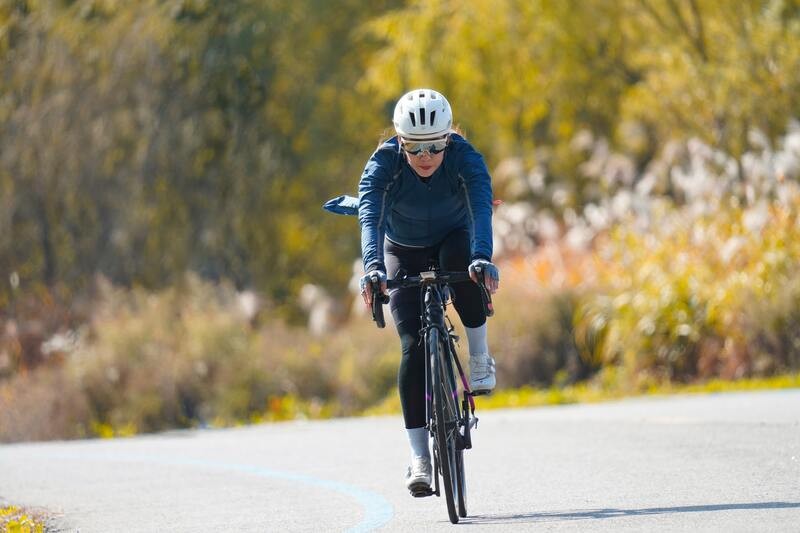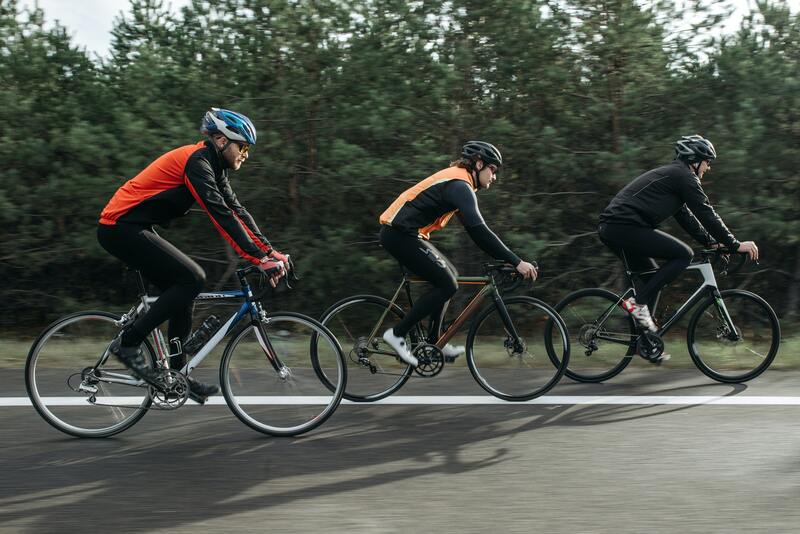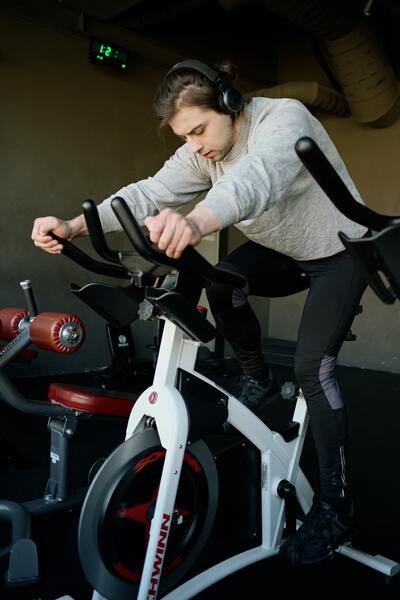It is no secret that wind is one of the biggest enemies of cyclists, and almost everyone has come across it at some point in their riding journey.
Now the question is when this enemy becomes so powerful that we are compelled to surrender and sit in our homes, plus what can be done to deal with it?
This article provides a comprehensive answer to this question, along with an effective strategy for dealing with cycling in wind.
Let’s start by talking about the wind you’ll be facing.
If the wind is light, it will feel like a gentle breeze. Alternatively, if it is extreme, you can feel like you are going backward when riding a bicycle.
Wind can negatively affect biking, and can reduce your speed by half, making it challenging to balance, blowing you off your bike track, and even causing you to fall off.
A cyclist who rides in strong winds may also experience dust and cold.
However, after reading this article, you will love and embrace winds with positivity. Because you will learn ways to deal with the wind in this article.
Moreover, we will discuss how you can use wind as a training resource when cycling. So without further ado, let’s get started.
Why is Cycling in Wind so tough
A cyclist who is riding in the wind may have their speed cut in half with the same amount of effort expended as they would if there was no wind. In other words, you need to work twice as hard to get the same results as before to achieve the average cycling speed.
The wind and the extra air resistance it creates can have a huge impact on cycling performance. It is estimated that aerodynamic drag contributes to 90% of your resistance when riding a bike.
The equation is even more tipped against you by strong winds. It is, therefore, difficult to compete in a race when fierce winds are blowing.
However, windy days can be an excellent training tool, which helps you develop raw power, leg strength, lightning speed, aerodynamic technique, and solid bike control, which are all very useful things to have when riding in the wind.
Remember, if you have the ability to work with the wind versus against it, then the howling wind will become your partner and not your nemesis.
How to plan a route on Windy Day
The whims of mother nature are beyond our control – even if they happen to bother us on the day that we hoped to achieve a personal best. There’s nothing we can do about them. But the way you handle the wind can, however, have a significant effect on your ride.
Here are some tips to help you make your riding easy and exciting on a windy day…
Check Weather Forecast
Make use of apps on your smart device to get some accurate weather forecasts. It’s easy to figure out the wind direction and strength with them. To determine the most significant draft, this information is essential.
Therefore, find out the weather conditions in your area in advance before you depart from home.
Go for Suitable Clothing & Gears

The proper clothing can effectively combat wind resistance created by strong winds. Keep your shorts and jersey as tight as possible while still being able to move comfortably.
Having tighter clothing will reduce the amount of fabric flapping about on your body as the wind slips around your body. This provides great aerodynamics and contributes to your overall performance.
Additionally, you’ll need an aerodynamic helmet to keep the wind from slipping over your head.
Choose Route Wisely
When riding on a windy day, it’s also a good idea to choose a location that is more sheltered, such as a park or hedgerow, with less buffering. You mustn’t lose sight of the gates, as any crosswind can cause you to be blown back and forth as you pass through them if you’re not paying attention.
It is important to keep your grip firmly on the handlebars and engage your core muscles when you move into an exposed area where you know there will be a big surge.
Maintain Aero Dynamic Position

On a bike; this is arguably the most prominent method of cheating the wind and probably the easiest. It all comes down to aerodynamics in the end.
For a cycling vehicle to perform well, it should be sleek, and wind-cutting, and, in our opinion, this is exactly what should be achieved by the cyclist.
As you sit on the bike with your torso erect, there is a greater chance that there will be headwinds that will come across your body. There is nowhere to go for these winds, so you will absorb them, and you will slow down as a result.
The best way to slice the wind is to lean forward into it and try to slice it as much as possible with your body. Rather than allowing the wind to push you, allow it to roll around your shoulders and back.
To learn really well in severe winds, move your butt farther back on the saddle and put your hands in the drops. With this technique, you are all set to fight those windy days.
Pedaling Tactics
If you are cycling in the wind, you might be tempted to spin fast to keep up with your normal pace line. The only thing this will do is make it bumpier, which is not a good thing.
“The faster you pedal, the more jerky it gets, and the more the bike goes side to side,” says Coach Darryl. In other words, the wind is already creating turbulence, and pedaling too hard only intensifies it.
For a cyclist, a typical cadence ranges from 75 to 85 rpm. To reduce your side-to-side movements during heavy winds, drop into a harder gear and reduce the speed by 8–10 rpm.
Drop Down your Gear
You should drop down into a lower gear than what you would normally use when you are riding on your bike. Basically, think of shifting gears like you would if you were on a hill and had to climb it.
To have better endurance, you’ll have to sacrifice some speed. You will struggle to maintain your speed if you push yourself to the limits.
Use Cycling in the Wind as training
On a day when it is blustery outside, you can do an interval workout with the wind at your back to help motivate you. The wind can be considered a particularly vicious spinning class instructor, giving you random orders that will make you want to keep pushing yourself even harder as you move forward.
If there is a headwind blowing, make sure that you make some high-power efforts in a big gear to build some strength and power. As soon as wind gusts, switch from a high to a low gear and increase your cadence to 120rpm. This will help you to improve your leg speed and cardio fitness.
This wind-assisted interval training will enable you to simulate the chaos and unpredictability of a race, plus you will also be able to have a great time out on windy rides.
Note: In wind training, your effort should be measured by feel, power, or heart rate rather than speed. After all, riding in the wind requires as much concentration and muscle strength as ascending a mountain.
Learn Wind Resistance Tactics
Wind resistance always has a profound effect on a rider’s tactics since he or she can use wind resistance as an advantage. The importance of aerodynamics becomes even more important at speeds over 30 kph, even if there is no strong wind involved.
As long as you position yourself correctly on the bike, you can limit the amount of surface area on the body where the wind can hit and cause friction on the bike.
A good position is to lean forward while drawing your elbows toward your body.
The person in front of you might not be in this position, making jumping into their slipstream easier, which could significantly reduce your wind resistance.
Avoid Deepest Wheels
In strong winds, never ride a road bike with deep section wheel rims on it. It is easy for them to catch crosswinds, like sails, and you have to fight your way forward to prevent being pushed to the right or left for better control of the steering.
Try Group Riding

Cycling on a windy day allows you to appreciate just how strong those winds can be when you’re out for a ride. The important lesson you’ll learn from that experience is the importance of following a wheel, finding shelter, and riding efficiently with others.
A study published in the Journal of Wind Engineering and Industrial Aerodynamics showed that a peloton faces less aerodynamic drag than a solo rider at the mid-to-the rear of the group. In other words, group dynamics are extremely important.
A windy day is a perfect time to practice group riding skills. Take a ride with some friends and practice riding behind the wheel, then take the lead and notice the difference.
On a windy day, riding with a group will teach you how to follow a wheel safely and securely, find shelter, and conserve energy. All key lessons you learned in group riding can be carried into the racing season.
Work with Wind Direction
Wind directions are classified into three primary types: wind coming from behind your body (tailwind), wind coming from your face (headwind), and wind coming from your side (crosswind).
If you want to ride faster and more efficiently even in windy conditions, you need to change your tactics based on the direction of the wind.
Training with Tailwind
It is a wind that blows in the same direction as the object being traveled.
Occasionally it can happen: you’ve pushed along, effortlessly cruising at a faster speed than you would normally cruise at. Take advantage of this whenever you can. But be sure to keep yourself under control at all times.
When you catch a really strong tailwind, you can reach a speed that is too fast, especially when you are riding downhill.
If you plan to go out for a leisurely cycle ride on a windy day, you should choose a route that will give you a tailwind when you arrive home. By doing this, you will be able to prevent yourself from biting off more than you can chew.
From our above discussion, it’s very clear that unlike riding into a headwind, which feels like a punishment from god, riding in a tailwind feels like a gift from heaven. If you ride with the wind behind you, you will be able to experience the same speeds that pro cyclists experience when they ride.
Make the most of your extra speed by turning the tailwind into a unique training stimulus. This will help you sharpen your speed by boosting your cadence and firing up your fast-twitch muscle fibers.
Aim for ten blasts with 2-3 minutes of rest between each one. During your next ride, you will notice that your leg speed has improved.
Training with Headwind
Unlike tailwinds, headwinds blow in the opposite direction of a traveling object. This means two things:
a) During a tailwind, it may be difficult to reach the same speed as on a typical day;
b) You struggle more in this period. In other words, not only is the speed reduced but even pedaling is difficult. The motion is similar to pedaling a bicycle in high gear or dialing up the tension on an exercise bike.
As cyclists, we spend a more extended amount of time riding in headwinds than tailwinds, so we feel that they are more frequent. It’s not easy to cycle against this wind. Accept that your journey will take longer than usual since you won’t be able to maintain your usual average speed.
Choose a gear that allows you to pedal at a reasonable cycling cadence and set off earlier so that you won’t have to ride flat out.
Strong headwinds slow your riding speed by about half. A 32kph headwind will make you crawl at around 14kph if you usually ride at 30kph in a flat and still condition.
It may seem like you’re riding uphill when riding into the headwind. It’s for this very reason that the dreaded headwind can be so powerful.
Don’t get frustrated and angry; instead, use the wind to boost your power and leg strength. With more resistance caused by the wind, climbing a hill feels more powerful and stronger.
It is for this reason that why pro-riders refer to strong winds as “Dutch hills.” These winds can help flatlanders prepare for mountain riding by simulating the challenge of climbing a mountain.
You should drop down a few gears next time you ride into a headwind and do 6-8 repetitions of 30-60 second power efforts. Set a cadence of 60-80rpm if possible, but allow 3-5 minutes between each effort for recovery.
When riding into headwinds like this, your leg strength, your power output, as well as your cardiovascular endurance will be boosted; then, you will be able to tackle steep climbs with ease. You will also be able to unleash a long solo effort to catch up to the group in front during races and sports events.
Training with Crosswind
There is no doubt that a strong crosswind can push any cyclist to the limit. The only thing that is keeping you in place, other than your own force of will and mass, is the traction of your bike’s tires on the surface of the tarmac.
The rider should take special care when there are fewer traction options available, such as when leaning into turns or riding on slippery surfaces such as those left by rain or snow. It is more likely to skip sideways when you have wider, softer tires because more rubber is in contact with the road.
If your handlebars are wide and flat, it provides you with more steering leverage so that you will be able to control your bike better in crosswinds.
In contrast, if your bike has a drop bar, ensure you don’t ride on top with your hands close together; instead, keep your hands on the brake hoods or drops so your hands are further apart.
Of all three wind directions, the crosswind poses the greatest risk. Why? Because the wind might literally pick you up and throw you away. Yes, really. Several accidents have occurred when there is a strong crosswind. So, ride wisely.
Stay Home — Do Indoor Cycling

When strong wind or poor air quality is present outside, cycling indoors is a great option. Take weather warnings seriously and plan to stay at home only.
The intense workout you will endure while cycling indoors requires a few things which allow you to perform at your best, including two towels; one to cover the handlebars during the workout and one to wipe sweat from your face.
Additionally, you’ll need a water bottle filled with water; athletic shoes that are stiff on the soles and cut low on the ankle; and comfortable workout clothes made of synthetic, sweat-wicking fabric that is lightweight and breathable.
This chart explains the different wind speeds so riders can decide when it’s safe to ride outside and when it’s best to stay indoors.
Cycling Wind Speed Chart:
| Wind Speed | Rideability |
| Less than 10 Mph | Safe for riding |
| 15 Mph | A little bit harder to ride |
| 20 Mph | Hard to ride |
| 30 Mph | Very tough to ride |
| 40 Mph | Not Rideable |
| 50 Mph or more | Very dangerous for Cycling |
Give Turbo Training An Opportunity
In turbo training, your bike is positioned onto an indoor turbo trainer or static bike device by which you cycle indoors. Using a turbo trainer is useful when it’s too dark, windy, or wet to cycle outside.
A turbo-training session also provides a structured session in which you can control the intensity and the resistance offered by the unit (using fluids, air, or magnetic forces) instead of having to rely on a road route.
How to Ride in an Echelon
It is common to see pro peletons split into echelons when strong side winds are present. When there is a strong cross wind, the best place to shelter is not directly behind a rider, but rather, slightly to one side of the rider in order to get the best protection.
Whenever the echelon extends across the road, cycling behind it becomes very hard because you are getting the impact of the crosswind once they span across the road.
An important aspect of an echelon is to keep moving up the line, take a short turn at the front, and then split to the back of the line in the direction of the wind as soon as you hit the back of the line.
The echelon system makes for exciting racing, but it can also be extremely challenging for the racers. The manta of strong crosswinds is riding in the top 20 to try and stay in the leading echelons when there are strong crosswinds. In other words, everyone fights for position, to stay at the top.
How to do Draft Cycling in Wind
The term drafting refers to when a cyclist moves into a low-pressure area behind another cyclist, overcomes air resistance they encounter, and, therefore, reduces the amount of energy they need to pedal.
There are many ways to experience drafting benefits over the course of a ride, such as rotating the lead rider to the back of the group or riding in a paceline where everyone can easily benefit from drafting.
By doing this correctly, you can reduce your effort by 30%, meaning you can go faster, and farther, and achieve more PRs.
What is the minimum distance you must be from drafting in order to experience its benefits
Although, you will conserve more energy as you get closer to the rider in front of you. It is possible to save up to 30% of energy sooner by riding as closely as possible without overlapping wheels with the rider in front of you.
However, if you are one full bike length behind the rider in front of you, it is still beneficial.
It is also important to consider the wind’s direction when positioning yourself behind the rider in front of you. Moving to the left of the rider in front of you is a good idea if the wind is blowing from the right.
When the wind blows from the left, make a slight right turn. As a result, the person in front blocks the majority of the wind, and you are protected from it behind him.
When you ride, you can determine the wind direction by watching trees or flags blowing on the side of the road.
Rotation is initiated from the front. As the lead rider looks out the direction they are going, he or she will make sure there are no cars or people coming up behind them. His elbow or hand will be pointed in the direction in which he is dropping off as a signal.
Gradually, his cadence will drop, allowing him to fall behind the pack. The last rider in line will announce his position, and the lead rider will now take over the rear position. Generally, leading or pulling the group for 0.5 – 1 mile (1 – 2 km) will keep everyone alert and feeling fresh.
It is the fifth rider in line who will save the most energy when riding in a single paceline. Savings taper off slowly before and after this position.
It is true that even the lead rider feels a boost from the rider drafting behind him or her. By pushing the lead rider along with low-pressure air bubbles, the lead rider is able to reach the same speed with a 3% reduction in energy output.
Final Thoughts — Cycling in Wind
The wind will never make cycling easy or enjoyable. Keeping in mind, these above-mentioned few tips will allow you to still be able to enjoy a good ride despite all of these factors.
With or without wind, the most important thing is to get out of the house and ride whenever you can, no matter how small the distance.
Have you got any more tips on how to ride a bike in the wind? We would appreciate it if you could leave a comment and let us know what you think. We would like to hear from you and learn more about your ideas.
You can follow our Facebook Page for more guides like this.
Have fun riding!
Cycling in Wind — FAQs
How much wind is too much for cycling?
A wind speed of more than 30mph (48 kph) is probably too much wind for most cyclists, while a wind speed of more than 40mph (64 kph) is considered a gale wind by most cyclists. Nevertheless, any amount of wind can make riding challenging.
Is it safe to cycle in the wind?
It can be dangerous to bike in high winds. Aside from the fact that this will make bike handling more challenging, there is also a risk of debris and obstacles falling from the sky.
The headwind of 20 mph (32 kph) is enough to cause small trees to sway, which can result in their branches being blown around by the wind. There is also a good chance that the rider will experience the gust of wind while riding his bike, and it could cause him to sway a bit.
However, it does not necessarily mean that it is dangerous for all riders. The important thing is to make sure you have a good understanding of your personal limits and level of comfort with risk.
Is 20 mph wind strong?
Biking in 20mph winds is possible, but not very enjoyable. When you’re putting out the same amount of wattage as on a normal ride, you’ll see your overall speed drop in half. In other words, you’ll be going 5mph instead of 15mph – it may feel like walking instead.
The best thing to do if you find yourself cycling in the wind like this is to turn around and bike home. As soon as you have the wind behind you, that horrible 20mph wind suddenly becomes your best friend.
Related:
